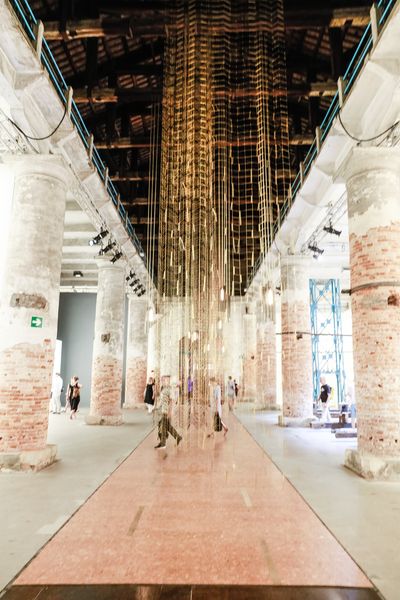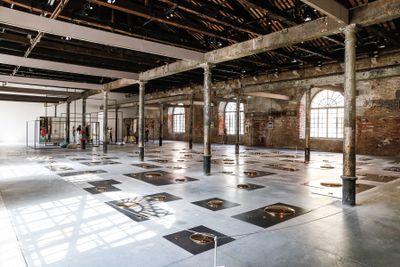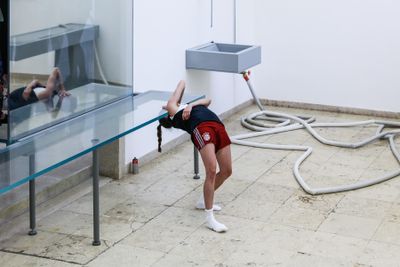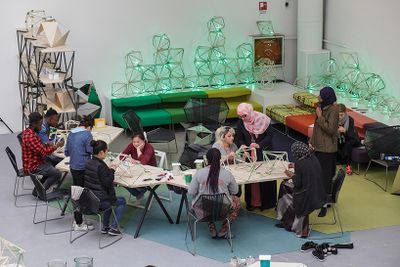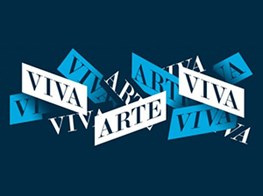Tilting the scale: on the 57th Venice Biennale
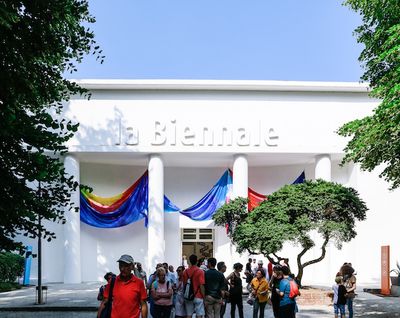
VIVA ARTE VIVA, the 57th International Art Exhibition, la Biennale di Venezia, Venice (13 May–26 November 2017). Courtesy Ocula. Photo: Charles Roussel.
Arriving in Venice involves many adjustments, the most important of which is getting accustomed to operating in an altered urban scale. Upon stepping out of a water taxi from the airport, the traveller faces a small city crisscrossed with narrow streets irrationally spread over a man-made and archipelagic substrate. These arteries, which are often barely wide enough for walking, are the only viable form of transportation for the city's inhabitants and its thousands of visitors. It is this miniature spatiality that gives Venice its charm and compels everyone to forgive its obvious infrastructural shortcomings. However, visiting the city during the opening days of the 57th Venice Biennale (13 May–26 November 2017) involves questioning scale from the opposite extreme. Faced with 86 national pavilions, 23 collateral projects and 4 concurrent festivals, in addition to scores of performances, publication launches and parties, one might ask: how far can a large-scale project like an international biennial go to expand the fixed space of a small city like Venice?
What is clear in 2017 is that since Venice can't physically expand, the growth of the art world and its audiences makes the city—already a heaving destination with a daily influx of up to 70,000 tourists—ever more claustrophobic. The 57th Venice Biennale feels larger than the past editions. The Biennale's director Christine Macel, chief curator of Paris' Centre Pompidou, has scaled up the singularity of the usual exhibition; the central show is now divided into nine conceptual 'Trans-Pavilions', rivaling those traditionally set up by participating nation-states. It also includes an 'Open Table' (Tavola Aperta) programme, held on Fridays and Saturdays, putting the artists and the visitors face-to-face for lunchtime conversations. Aside from hosting the usual educational programmes, the Biennale is also hosting the 'Artists' Practices Project' at the Giardini and the Arsenale, through which artists, vis-à-vis video documentaries, introduce their work and discuss their methods. The 'Unpacking My Library' project, which is a large compilation of books chosen by the Biennale's participating artists, is yet another unfolding of the exhibition's fixed physical space.
Then there are the Biennale's collaborations with the Victoria & Albert Museum on the Pavilion of Applied Arts. Curated by artist Jorge Pardo, the exhibition Starting to get the ex wife out of my summer house... and maybe some issues in objecthood along the way... merges art and design to create an architectural collage of archival materials in the Sale d'Armi in the Arsenale. Besides the collateral programming, several large-scale exhibitions, as per the norm, have also been staged independently in the city by other institutions. There is Fondazione Prada's The Boat is Leaking. The Captain Lied, featuring Thomas Demand, Alexander Kluge and Anna Viebrock; Galleria dell'Academia di Venezia's comprehensive survey titled Philip Guston and The Poets; and Damien Hirst's oversized and doubled-up Treasures from the Wreck of the Unbelievable, which occupies the Pinault Foundation's Palazzo Grassi and Punta Della Dogana.
The hyper-scaled Hirst show seems to metaphorically stand in for the artist and his life as he uses the occasion to inject new blood into his career. Hollow but grand, the exhibition consists of 190 artworks at sizes ranging from one inch to fifty feet, all supposedly salvaged from a sunken ship called the Apistos (meaning 'the Unbelievable' in Greek) and belonging to a freed slave. As a visual phenomenon, it is impossible to see this fantasy project and its 'treasures' separately from the large crowds photographing the works from every possible angle. The exhibition feels like a giant 3D printed mess of fake artefacts and art. The only 'truth' in the show, so to speak, is in the giant National Geographic-style documentary photos and projected videos on display, which substantiate the artist's joke and grants it pictorial relevancy. On the level of ambition and not necessarily its content, the exhibition is an object lesson to Jeff Koons as well as the younger, post-internet generation, in that it demonstrates how an artist can successfully quantify his or her ambitions in the age of the internet and social media by producing bombastic, instagrammable spectacles designed for FOMO-inducing digital dissemination. Awkward was how everyone, including the staff at both museums showing Hirst's work, felt obliged to express disdain for the project. Hardly anyone in the real art world, certainly not in public, felt safe to express enthusiasm or demonstrate any interest in the show, lest he or she come across as approving of the work's economy, aesthetics and/or political message. The long queues outside of the exhibitions, however, told a different story. It seems this OBA (Hirst is an Old British Artist by now, after all) successfully upstaged the Biennale and gave the city a successfully mediated show that was experienced far beyond the confines of Venice itself through the online coverage it generated.
This is all good news for the city of Venice. Speaking to an Italian curator familiar with the inner workings of the Biennale, the main marketing strategy of the organisers in the past few years has been to use the exhibition's opening days as an opportunity for growing a new tourist audience. According to my source, the city loves the art crowd not only because they spend more than the average tourist on food and accommodation, but because their real and online social networks—often wider and more influential than that of the average tourist—function as free marketing for the city. With crowds ever surging, however, veterans of the Biennale this year reminisced about the quieter vernissages of past editions, which allowed for a special and intimate look at the works. Many expressed a serious consideration to next time skip the opening days—characterised by the sheer scale of social events taking place during this period—in order to visit the exhibition afterwards.
The overcrowdedness of the opening days do feel like a kind of litmus test for a pavilion's quality, though. For example, there wasn't a single time during several visits to the Giardini that I could comfortably enter the Golden Lion award winning-German Pavilion to see Anne Imhof's time-based installation Faust (2017). The work consists of choreographed performers who look and dress like young, beautiful fashion models, playing around with a pack of black Dobermans who pace inside a cage outside the pavilion building. Inside the pavilion, a well-engineered glass floor doubles as the walking surface for viewers and a platform for the performers. The long queues outside the German pavilion during the opening days, together with the imposing architecture of the building and the consciously authoritarian aesthetics of the exhibit, created an unpleasant air of superiority. The experience was another reminder that larger quantities, even in the world of art, can easily substitute or at least be conflated with higher qualities.
But is bigger necessarily better in the context of art? Not really. Macel's structuring of the central show through a series of conceptual pavilions was completely unnecessary, especially with silly names like 'The Pavilion of Artists' (aren't all of them?), 'The Pavilion of the Earth' (how about 'Earth as a Pavilion'?), 'The Pavilion of Traditions' (which ones?), 'The Pavilion of Shamans' (you must be joking?), and 'The Pavilion of Colours' (bring your crayons). Some viewers thought that the curator had tried but failed to hide the theme-lessness of her exhibition behind totally arbitrary and excessive categories. The result was a dull attempt at re-staging the lost autonomy of art in the age of political uncertainty. But is it really possible to, all of a sudden, rebrand art as an enchanting social activity away from specific social, theoretical or technological issues? Good luck with that! Especially when, in the heart of the central pavilion at the Giardini, Olafur Eliasson's 'artistic workshop' titled Green Light displays actual refugees working for no real pay, building lights in front of enlarged doodles by Edi Rama, the current neoliberal Prime Minister of Albania. Overall, the curated show looks and feels like a series of art fair showrooms, and the works, even in some of the national pavilions, are nothing but. In many cases, art was being sold to collectors who were in Venice to dash, dine and purchase investment commodities at pre-sale prices like a stock market IPO.
But the biggest elephant in the Venice Biennale's figurative room is how little relevance the idea of presenting national art holds in today's hyperglobalised, cloud-based, always-on-the-run, and always-on-the-airplane art world. Will there come a day when the weakening of national governments is so severe that the only concrete parts that will remain of this Westphalian skeuomorph are their corresponding buildings in the Giardini? Will the countries that never got a chance to have a pavilion for art and architecture in Venice even be remembered as nations?
This is why Geoffrey Farmer's earnest (de)installation in the Canadian Pavilion is one of the only official exhibitions that dealt properly with the political obsolescence of national art. Taking advantage of the necessary renovations to the building resulting from storms, Farmer successfully turned the Canadian Pavilion into its own ruin. He even painted the pavilion's name, which is usually white, in black. Central to the exhibition is a fountain built using parts from New York's Washington Square Park's, while its surrounding pool is a copy of the original Moorish-tiled structure at the San Francisco Institute of Art, where Farmer studied in the 1990s. Water periodically shoots out of the fountain, wreaking further havoc on the partially destroyed building, with an exploded roof offering a metaphor for the ruinous condition the form of the nation state finds itself in, and the long-running tradition of representing national art in an international context.
The Canadian Pavilion also acts as a warning to the state of the city of Venice itself. How much more can the Venice Biennale grow; how many more artists, tourists, and artist-tourists can it fit before it explodes at the seams? One idea that can hopefully be entertained by the next edition's future curator is doing more with less by organising a rigorous Biennale that involves fewer materials and spaces.—[O]

